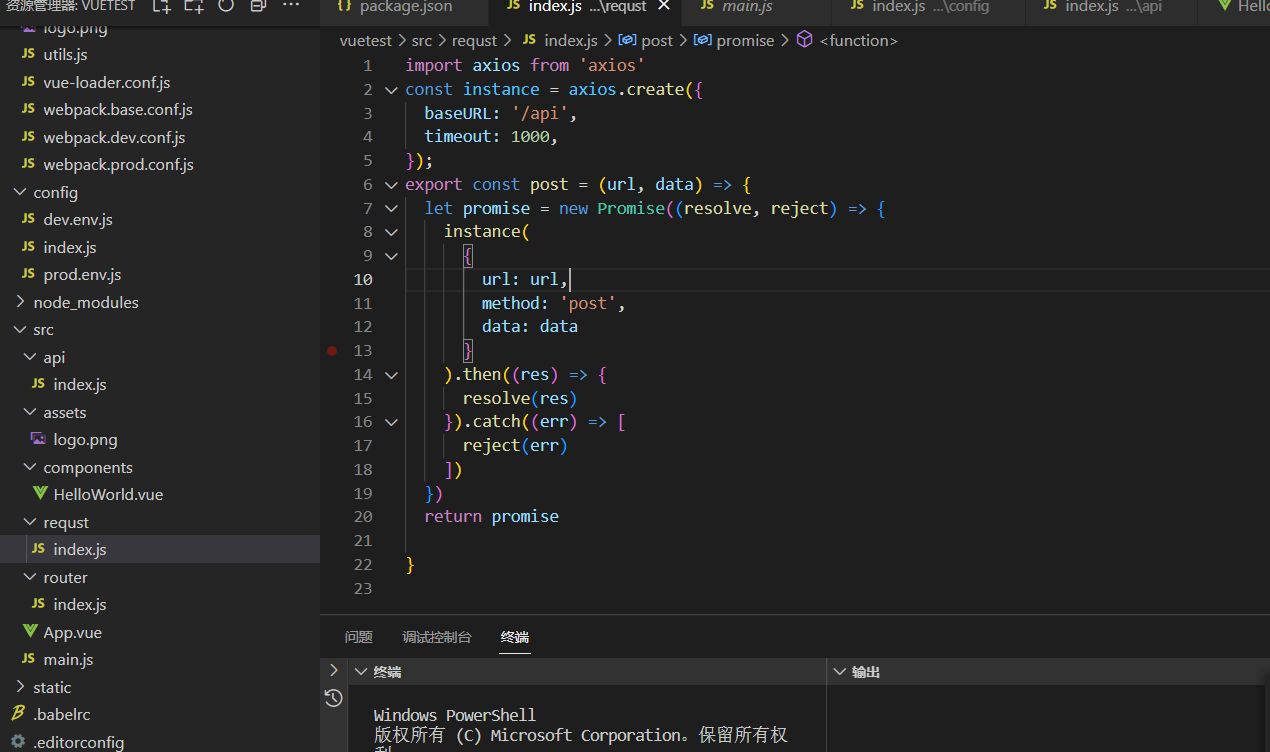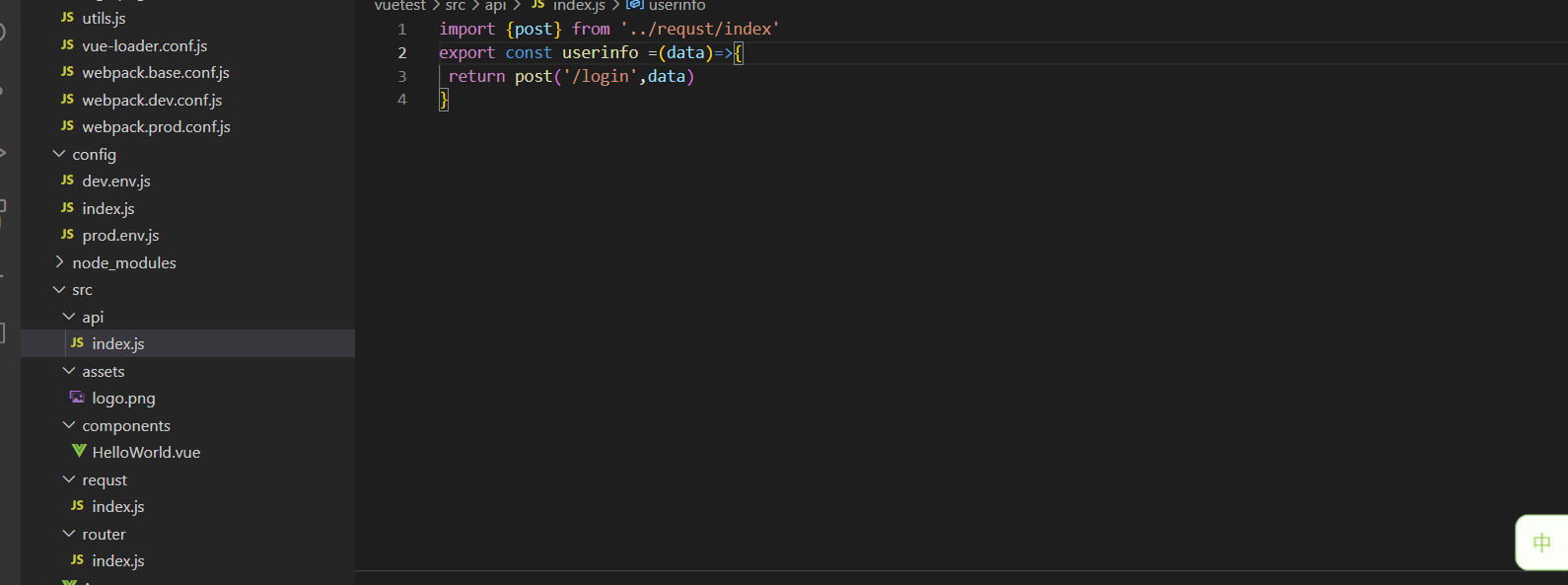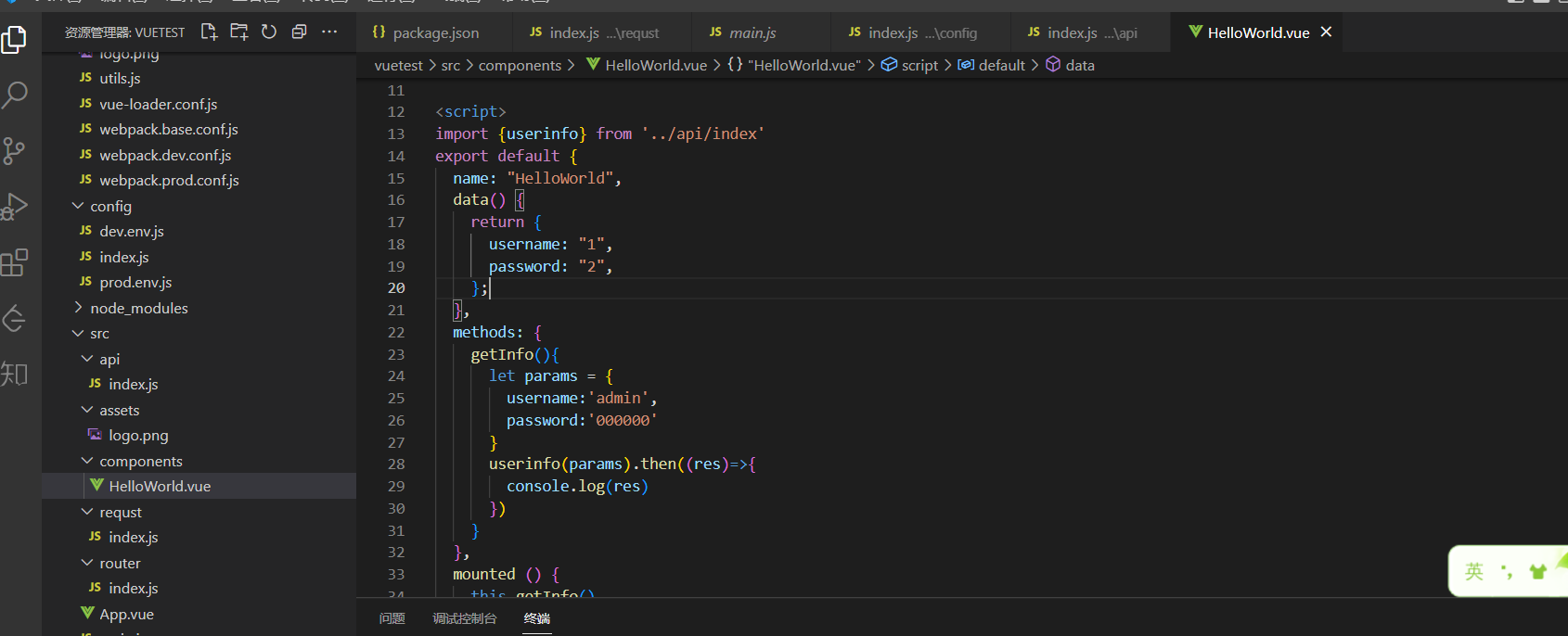搭建一个node+vue的项目
一.使用express搭建一个服务
1 2 3 4 5 6 7 8 9 10 11 12 13 14 15 16 17 18 19 20 21 22 23 24 25 26 27 28 29 30 31 32 33 34 35 36 37 38 39 40 41 42 43 44 45 | //1.导入expressconst express = require('express')//2.调用express函数,它的返回值就是服务器的实例const app = express()//TODO_01配置session中间件const bodyParser = require('body-parser')//引入第三方中间件,要在router之前引入才能通过req.body获取到请求的数据app.use(bodyParser.json());app.use(bodyParser.urlencoded({extended:false}))const session = require('express-session')app.use(session({ secret: 'itheima', resave: false, saveUninitialized: true}))//TODO_02请将登录成功后的用户信息保存到session当中app.post('/api/login', (req, res) => { console.log(req.body,req.session) if (req.body.username !== 'admin' || req.body.password !== '000000') { return res.send({ status: 1, mesg: '登录失败' }) } console.log(req.body) //注意只有成功配置了express-session中间件之后才能通过req 点出来session这个属性 req.session.user = req.body//用户信息 req.session.isLogin = true//用户登录状态 res.send({ status: 0, mesg: '登录成功' })})//TODO_03从session中获取用户的名称,响应给客户端//1.判断是否登录//退出登录接口app.post('/api/logout', (req, res) => { //TODO_04清空session req, session.destroy() res.send({ status: 0, msg: '退出登录成功' })})app.listen(80, () => { console.log('express server running at http://127.0.0.1')}) |
注意:
1 2 3 4 | const bodyParser = require('body-parser')//引入第三方中间件,要在router之前引入才能通过req.body获取到请求的数据app.use(bodyParser.json());app.use(bodyParser.urlencoded({extended:false}))二.使用vue搭建一个前端项目,并引入axios,封装接口,配置跨域npm install aixos -gnpm install vue-axios -g然后在main.js中使用 |
1 2 3 4 5 6 7 8 9 10 11 12 13 14 15 16 17 18 | // The Vue build version to load with the `import` command// (runtime-only or standalone) has been set in webpack.base.conf with an alias.import Vue from 'vue'import App from './App'import router from './router'import axios from 'axios'import VueAxios from 'vue-axios'Vue.config.productionTip = falseVue.prototype.$axios =axiosVue.use(VueAxios, axios)/* eslint-disable no-new */new Vue({ el: '#app', router, components: { App }, template: '<App/>'}) |
1 | 封装axios方法 |
1 2 3 4 5 6 7 8 9 10 11 12 13 14 15 16 17 18 19 20 21 22 | import axios from 'axios'const instance = axios.create({ baseURL: '/api', timeout: 1000,});export const post = (url, data) => { let promise = new Promise((resolve, reject) => { instance( { url: url, method: 'post', data: data } ).then((res) => { resolve(res) }).catch((err) => [ reject(err) ]) }) return promise} |
1 |

封装api

调用api

在config文件夹下的Index.js的proxyTable对象中配置跨域
1 2 3 4 5 6 7 8 9 10 11 12 13 14 15 16 17 18 19 20 21 22 23 24 25 26 27 28 29 30 31 32 33 34 35 36 37 38 39 40 41 42 43 44 45 46 47 48 49 50 51 52 53 54 55 56 57 58 59 60 61 62 63 64 65 66 67 68 69 70 71 72 73 74 75 76 77 78 | 'use strict'// Template version: 1.3.1// see http://vuejs-templates.github.io/webpack for documentation.const path = require('path')module.exports = { dev: { // Paths assetsSubDirectory: 'static', assetsPublicPath: '/', // Various Dev Server settings host: 'localhost', // can be overwritten by process.env.HOST port:81, // can be overwritten by process.env.PORT, if port is in use, a free one will be determined autoOpenBrowser: false, proxyTable:{ '/api':{ target:"http://127.0.0.1:80/api", changeOrigin: true, ws: true, pathRewrite: { "^/api": "", }, } }, errorOverlay: true, notifyOnErrors: true, poll: false, // https://webpack.js.org/configuration/dev-server/#devserver-watchoptions- /** * Source Maps */ // https://webpack.js.org/configuration/devtool/#development devtool: 'cheap-module-eval-source-map', // If you have problems debugging vue-files in devtools, // set this to false - it *may* help // https://vue-loader.vuejs.org/en/options.html#cachebusting cacheBusting: true, cssSourceMap: true }, build: { // Template for index.html index: path.resolve(__dirname, '../dist/index.html'), // Paths assetsRoot: path.resolve(__dirname, '../dist'), assetsSubDirectory: 'static', assetsPublicPath: '/', /** * Source Maps */ productionSourceMap: true, // https://webpack.js.org/configuration/devtool/#production devtool: '#source-map', // Gzip off by default as many popular static hosts such as // Surge or Netlify already gzip all static assets for you. // Before setting to `true`, make sure to: // npm install --save-dev compression-webpack-plugin productionGzip: false, productionGzipExtensions: ['js', 'css'], // Run the build command with an extra argument to // View the bundle analyzer report after build finishes: // `npm run build --report` // Set to `true` or `false` to always turn it on or off bundleAnalyzerReport: process.env.npm_config_report },} |
配置完成之后将请求的baseurl换成/api即可,这是/api实际上就表示 http://127.0.0.1:80/api
1 |
1 |
1 | |
本文作者:SadicZhou
本文链接:https://www.cnblogs.com/SadicZhou/p/16837598.html
版权声明:本作品采用知识共享署名-非商业性使用-禁止演绎 2.5 中国大陆许可协议进行许可。





【推荐】国内首个AI IDE,深度理解中文开发场景,立即下载体验Trae
【推荐】编程新体验,更懂你的AI,立即体验豆包MarsCode编程助手
【推荐】抖音旗下AI助手豆包,你的智能百科全书,全免费不限次数
【推荐】轻量又高性能的 SSH 工具 IShell:AI 加持,快人一步